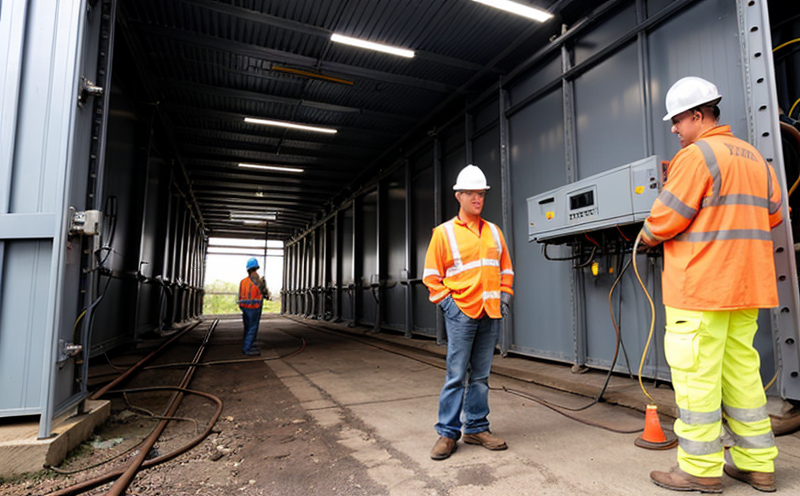Substation equipment inspection
In the realm of electrical and electronic systems inspection, substation equipment inspection is a critical process that ensures the safe and reliable operation of substations. Substations are integral nodes in power distribution networks where electricity is transformed between high voltage and low voltage levels for efficient delivery to end-users. The integrity and performance of substation components directly impact grid reliability, safety, and cost-effectiveness.
The inspection process involves a thorough evaluation of all substation equipment including transformers, circuit breakers, switchgear, control panels, capacitors, reactors, and other auxiliary equipment. These inspections are essential for detecting potential issues before they escalate into failures that could disrupt power supply or cause safety hazards. Depending on the specific type of equipment and the regulatory requirements, these inspections may be conducted on a regular basis (e.g., annually) or after major incidents.
The inspection process typically involves visual checks, non-destructive testing (NDT), and sometimes destructive testing to assess the structural integrity and performance characteristics of various components. For instance, ultrasonic testing can be used to evaluate insulation quality in transformers, while partial discharge testing is crucial for identifying early signs of insulation degradation.
Compliance with international standards such as IEC 60270 (Insulation Coordination for AC Systems), IEEE C37.110-2014 (Guidelines for Insulated Current-Carrying Parts in AC Switchgear and Controlgear), and EN 50618 (High Voltage Switchgear and Controlgear – Terminology) is paramount to ensure that inspections are conducted consistently with industry best practices.
During the inspection, detailed records are kept on any anomalies observed. These records form a critical part of the maintenance history for each piece of equipment. Over time, these records help in predicting future failures and planning preventive maintenance activities more effectively.
The findings from substation inspections also play a crucial role in optimizing operational efficiency. By identifying weak points early, utilities can implement targeted upgrades that enhance system reliability without unnecessary overhauls. This proactive approach not only minimizes downtime but also reduces long-term costs associated with unscheduled outages and repairs.
Applied Standards
The application of internationally recognized standards is fundamental to ensuring the accuracy, consistency, and reliability of substation equipment inspections. Key international standards that guide this process include:
| Standard | Description |
|---|---|
| IEC 60270 | Insulation Coordination for AC Systems, which provides guidelines on how to coordinate the insulation levels of electrical equipment in AC systems. |
| IEEE C37.110-2014 | Guidelines for Insulated Current-Carrying Parts in AC Switchgear and Controlgear, detailing design and testing requirements for insulated components within switchgear assemblies. |
| EN 50618 | High Voltage Switchgear and Controlgear – Terminology, providing definitions and terminology used across the industry to ensure clear communication during inspections and maintenance activities. |
| ASTM F2963-14 | American Society for Testing Materials standard that specifies procedures for determining dielectric strength of solid insulation in switchgear. |
The implementation of these standards ensures that inspections are conducted using uniform methods and criteria, thereby maintaining high levels of quality and safety across different jurisdictions. Compliance with these standards is often a prerequisite for regulatory approval and certification, making it essential for utility companies and other stakeholders to adhere strictly.
Industry Applications
The application of substation equipment inspection spans various sectors including power generation, transmission, distribution, and renewable energy integration. Here are some key areas where this service finds extensive use:
| Sector/Application | Description |
|---|---|
| Power Generation Facilities | In large-scale power generation plants, substations play a pivotal role in transferring generated electricity to the main grid. Regular inspections ensure that all equipment operates efficiently and safely. |
| Transmission Networks | For long-distance transmission lines, substations are crucial for stepping down voltage levels before distribution. Inspections here focus on identifying potential issues that could affect reliability over vast geographic areas. |
| Distribution Systems | In urban and rural settings, distribution substations bring electricity closer to end-users. Inspection here ensures continuity of supply and minimizes outages. |
| Renewable Energy Integration | With increasing adoption of renewable energy sources like solar and wind, modernization of existing substation infrastructure is necessary. Inspections in this context ensure compatibility with new technologies while maintaining robust performance standards. |
The importance of substation equipment inspection cannot be overstated, especially considering the growing complexity of today’s electrical systems. As technology advances and demand for reliable power increases, the role of these inspections becomes even more critical in sustaining global energy supplies.
Eurolab Advantages
EuroLab is a leading provider of substation equipment inspection services tailored to meet the stringent requirements of the electrical and electronic industries. Our expertise spans several decades, during which we have developed specialized methodologies and advanced technologies that set us apart from our competitors.
Comprehensive Range of Services: EuroLab offers a full spectrum of inspection services for all types of substation equipment. From transformers to control panels, our team uses cutting-edge instruments and techniques to provide thorough assessments. Our services are designed to cover not only routine inspections but also specialized tests required by specific regulatory bodies.
Expertise in International Standards: With a strong commitment to adhering to international standards, EuroLab ensures that all inspection processes comply with the latest guidelines. This guarantees that our clients receive results that meet global expectations and are accepted worldwide.
Dedicated Quality Assurance: Our rigorous quality assurance protocols ensure that every inspection is conducted meticulously and accurately. Detailed reports are generated for each inspection, providing comprehensive insights into current equipment status as well as recommendations for future maintenance or upgrades.
Experience and Reputation: Over the years, EuroLab has built an unmatched reputation in the industry for delivering reliable and accurate results. Our experienced team of engineers and technicians is dedicated to maintaining this high standard, ensuring that our clients can trust us with their most critical assets.
Client-Centric Approach: Understanding that each client’s needs are unique, EuroLab offers customized inspection packages that cater specifically to individual requirements. Whether it's a one-time inspection or ongoing monitoring services, we tailor our offerings to fit the specific demands of our clients.





